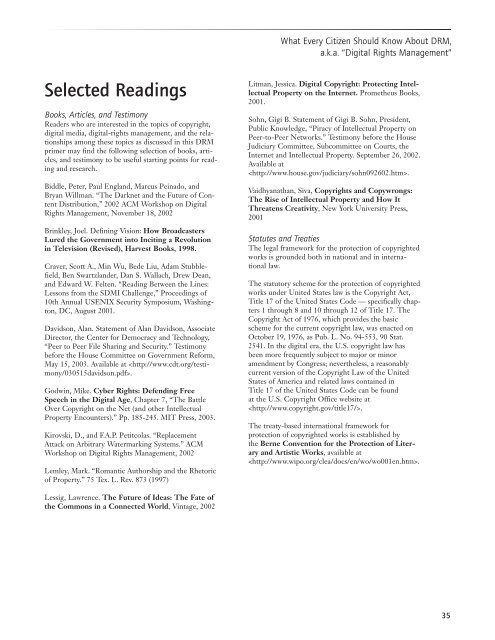What Every Citizen Should Know About DRM, aka - Public Knowledge
What Every Citizen Should Know About DRM, aka - Public Knowledge
What Every Citizen Should Know About DRM, aka - Public Knowledge
You also want an ePaper? Increase the reach of your titles
YUMPU automatically turns print PDFs into web optimized ePapers that Google loves.
<strong>What</strong> <strong>Every</strong> <strong>Citizen</strong> <strong>Should</strong> <strong>Know</strong> <strong>About</strong> <strong>DRM</strong>,a.k.a. “Digital Rights Management”Selected ReadingsBooks, Articles, and TestimonyReaders who are interested in the topics of copyright,digital media, digital-rights management, and the relationshipsamong these topics as discussed in this <strong>DRM</strong>primer may find the following selection of books, articles,and testimony to be useful starting points for readingand research.Biddle, Peter, Paul England, Marcus Peinado, andBryan Willman. “The Darknet and the Future of ContentDistribution,” 2002 ACM Workshop on DigitalRights Management, November 18, 2002Brinkley, Joel. Defining Vision: How BroadcastersLured the Government into Inciting a Revolutionin Television (Revised), Harvest Books, 1998.Craver, Scott A., Min Wu, Bede Liu, Adam Stubblefield,Ben Swartzlander, Dan S. Wallach, Drew Dean,and Edward W. Felten. “Reading Between the Lines:Lessons from the SDMI Challenge,” Proceedings of10th Annual USENIX Security Symposium, Washington,DC, August 2001.Davidson, Alan. Statement of Alan Davidson, AssociateDirector, the Center for Democracy and Technology,“Peer to Peer File Sharing and Security.” Testimonybefore the House Committee on Government Reform,May 15, 2003. Available at .Godwin, Mike. Cyber Rights: Defending FreeSpeech in the Digital Age, Chapter 7, “The BattleOver Copyright on the Net (and other IntellectualProperty Encounters).” Pp. 185-245. MIT Press, 2003.Kirovski, D., and F.A.P. Petitcolas. “ReplacementAttack on Arbitrary Watermarking Systems.” ACMWorkshop on Digital Rights Management, 2002Lemley, Mark. “Romantic Authorship and the Rhetoricof Property.” 75 Tex. L. Rev. 873 (1997)Litman, Jessica. Digital Copyright: Protecting IntellectualProperty on the Internet. Prometheus Books,2001.Sohn, Gigi B. Statement of Gigi B. Sohn, President,<strong>Public</strong> <strong>Know</strong>ledge, “Piracy of Intellectual Property onPeer-to-Peer Networks.” Testimony before the HouseJudiciary Committee, Subcommittee on Courts, theInternet and Intellectual Property. September 26, 2002.Available at.Vaidhyanathan, Siva, Copyrights and Copywrongs:The Rise of Intellectual Property and How ItThreatens Creativity, New York University Press,2001Statutes and TreatiesThe legal framework for the protection of copyrightedworks is grounded both in national and in internationallaw.The statutory scheme for the protection of copyrightedworks under United States law is the Copyright Act,Title 17 of the United States Code — specifically chapters1 through 8 and 10 through 12 of Title 17. TheCopyright Act of 1976, which provides the basicscheme for the current copyright law, was enacted onOctober 19, 1976, as Pub. L. No. 94-553, 90 Stat.2541. In the digital era, the U.S. copyright law hasbeen more frequently subject to major or minoramendment by Congress; nevertheless, a reasonablycurrent version of the Copyright Law of the UnitedStates of America and related laws contained inTitle 17 of the United States Code can be foundat the U.S. Copyright Office website at.The treaty-based international framework forprotection of copyrighted works is established bythe Berne Convention for the Protection of Literaryand Artistic Works, available at.Lessig, Lawrence. The Future of Ideas: The Fate ofthe Commons in a Connected World, Vintage, 200235





